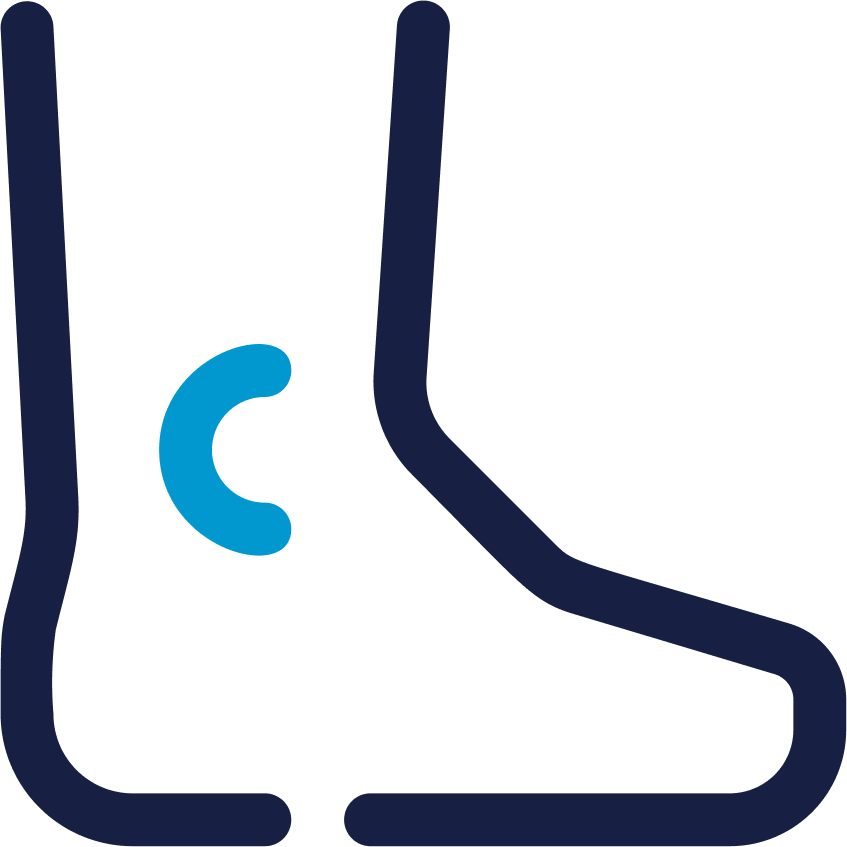
- Specialty Procedures
- /Foot/Ankle

Bunion correction surgical procedures realign soft tissue, bones, and/or joint fusions. Corrective surgery for bunions works to restore the natural alignment of the first toe joint and repairs soft tissue surrounding the joint of the big toe, thus relieving pain.
Because bunions vary in size and shape, there are different bunion correction procedures to correct them. A Pensacola orthopedic ankle and foot surgeon can determine which treatment you need. Below is an overview of the types of the many bunion correction procedures available.
Chevron Osteotomy
A Chevron osteotomy is a very common corrective bunion surgery. It consists of the orthopedic surgeon cutting the end of the metatarsal bone – the long bone which leads to the big toe. The procedure, which is generally performed for mild to moderate bunion deformity, can also be carried out along with soft tissue loosening or tightening around the joint.
Akin Osteotomy
In the Akin Osteotomy procedure, areas of bone are removed, and the foot and toes bones are then correctly realigned, thus eliminating the bunion bump on the inner side of the foot.
Lapidus Procedure
This procedure involves the fusion of the first TMT joint which inhibits the joint’s movement and straightens the toe and first metatarsal. Lapidus Procedure is for bunions which are the result of first TMT joint hypermobility and is to treat hallux valgus. The medial cuneiform bone is fused or locked to the first metatarsal, keeping the toe straight and preventing the recurrence of the bunion.
McBride Procedure
This is similar to the Silver procedure described below in terms of the bony bump removal and soft tissue being released to realign the big toe. The McBride Procedure works best for early bunion development as it doesn’t provide the same level of correction as bone cutting procedures.
Silver Procedure
This enlarged bump removal is carried out during the majority of bunion surgeries but is less common as a standalone procedure. This is due to the fact that it doesn’t address the cause of the bunion.
Chevron Osteotomy
Those who have tried and had no luck with non-invasive treatments, such as wider shoes, toe spacers, and shin splints may opt for this treatment. It’s useful for individuals suffering from a sore bump sometimes with irritation in the area.
Akin Osteotomy
The Akin Osteotomy is most often performed in conjunction with another bunion surgery, as it has limited use as a sole procedure.
Lapidus Procedure
This procedure works for those who suffer from a painful bump on the joint of the big toe, pain and/or hypermobility at the first TMT joint, problems wearing shoes due to the issue and pain that doesn’t improve through non-surgical means.
McBride Procedure
The McBride bunionectomy is an extension of the Silver Procedure and is used when a tendon from the base of the big toe needs to be transferred to the first metatarsal bone in the foot in order to correct an angular deformity of the foot. It is the commonly chosen procedure for early bunions.
Silver Procedure
The Silver bunionectomy may be performed on young patients with prominent bunions with mild deformity and ankle issues. It is often performed along with other bunion correction procedures, such as the Chevron and McBride.
Chevron Osteotomy
Performed as an outpatient procedure, this first toe joint realignment and filing down of the painful bump, usually, restores the foot to its pre-bunion appearance.
Akin Osteotomy
This procedure is carried out on the big toe and involves removing a wedge-like piece of bone, then fixing this in place with a screw or staple. The patient must wear a special surgical shoe after the procedure. Normal physical activities can be resumed within around eight weeks.
Lapidus Procedure
Usually carried out on an outpatient basis and under anesthesia, an incision is made and cartilage lining the first TMT joint is removed and the bones repositioned.
McBride Procedure
The McBride bunionectomy involves performing a soft tissue release and removing the bony bump in order to realign the big toe.
Silver Procedure
This procedure removes the bony bump, and is often done along with other bunion correction procedures.
Chevron Osteotomy
You will need to wear a dressing, a special shoe and will have to keep your foot elevated at chest level for a few weeks after your surgery. You may also need to do some special exercises. After two weeks, stitches are usually removed and it should be noted that swelling can last as long as a few months after surgery.
Akin Osteotomy
For the first two to four days, you will be required to rest, with your feet up as much as possible. During these first four days, you will need to restrict walking and use crutches. Seven days after your Akin procedure, you will to have your foot redressed, and two weeks after the surgery, you can have your sutures removed. Starting at weeks six through eight, you can return to wearing shoes. Depending on your recovery, you can return to sports around three months post surgery.
Lapidus Procedure
The initial two weeks after surgery involve keeping the foot elevated. Within a month of the procedure staples/stitches are removed and the foot is placed into a surgical shoe, boot or cast and will continue to be non-weight-bearing for a few more weeks. When the foot is fully healed, the shoe or boot can be eventually discarded and occasionally physical therapy may be needed. Discomfort and swelling can continue for as much as a year after surgery.
McBride Procedure
After a McBride bunionectomy, patients typically are allowed to walk immediately with a surgical shoe, which is worn for about one month. Beginning in the second month post surgery, most people can return to wearing an athletic shoe.
Silver Procedure
After a Silver bunionectomy, patients typically are allowed to walk immediately with a surgical shoe, which is worn for about one month. Beginning in the second month post surgery, most people can return to wearing an athletic shoe.

